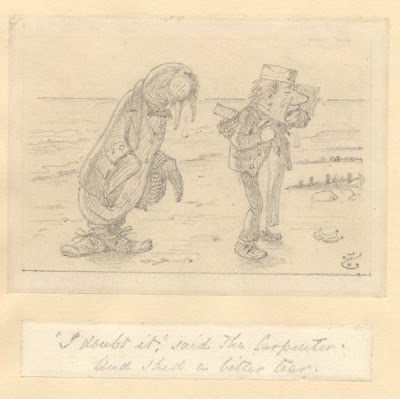Beach season is winding down as the end of the summer approaches and here at the Rosenbach we’re starting to gear up for Alice-in-Wonderland season as we make preparations for “Down the Rabbit Hole” a three gallery exhibit that will open October 14, along with a fabulous slate of programs ranging from a conversation with Maira Kalman, Alexandra Horowitz, and Maria Popova to tea and tarts with a tea connoisseur. Appropriately, today’s blog object combines both the beach and Alice.
 |
| John Tenniel, “‘I doubt it,’ said the Carpenter.” [1870 or 71].1954.27. The Rosenbach of the Free Library of Philadelphia |
the Walrus and the Carpenter is one of fifty illustrations which Sir John
Tenniel produced for Through the Looking
Glass and What Alice Found There. It depicts the pair tramping along the sand, which, strangely, upsets them.
The character of the Carpenter was Tenniel’s own invention–when Carroll gave Tenniel the manuscript he offered him the choice of drawing a carpenter, a butterfly, or a baronet, since any of these three-syllable words would fit the poem’s meter. Tenniel exerted significant influence over other aspects of Looking Glass as well; at his insistence Carroll dropped an entire episode, “The Wasp and the Wig,” because it was “altogether beyond the appliances of art.”
In Looking Glass, the Walrus and the Carpenter poem famously ends with them devouring a group of oysters whom they have lured out for a walk.
an 1886 operetta version of Alice,
allowing the ghosts of the oysters to wreak revenge on the Walrus and Carpenter:
tears are all a sham!
You’re greedier for Oysters than
children are for jam.
You like to have an Oyster to give
a meal a zest–
Excuse me, wicked Walrus,
for stamping on your chest!
For stamping on your chest!
For stamping on your chest!
Excuse me, wicked Walrus,
For stamping on your chest!

